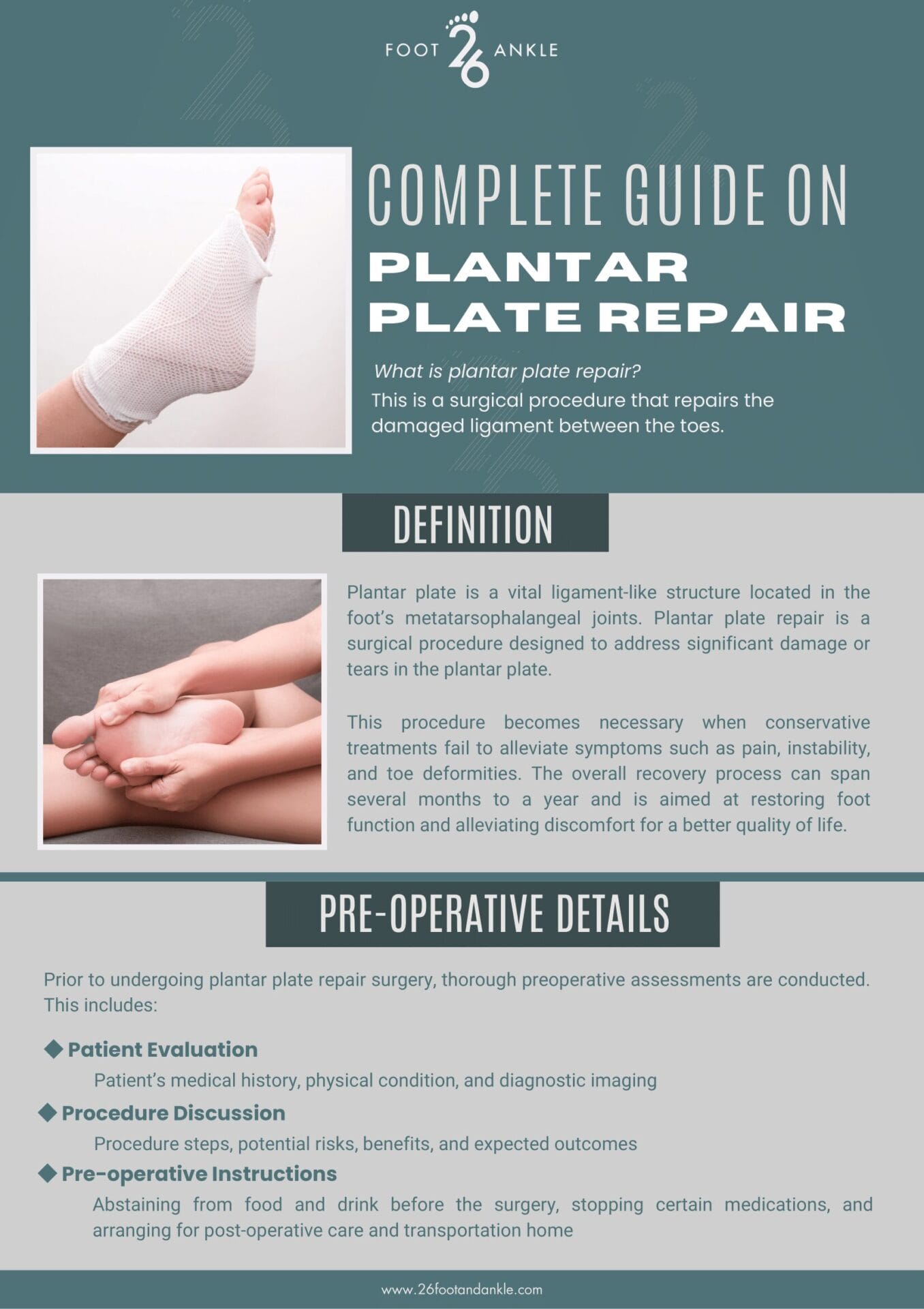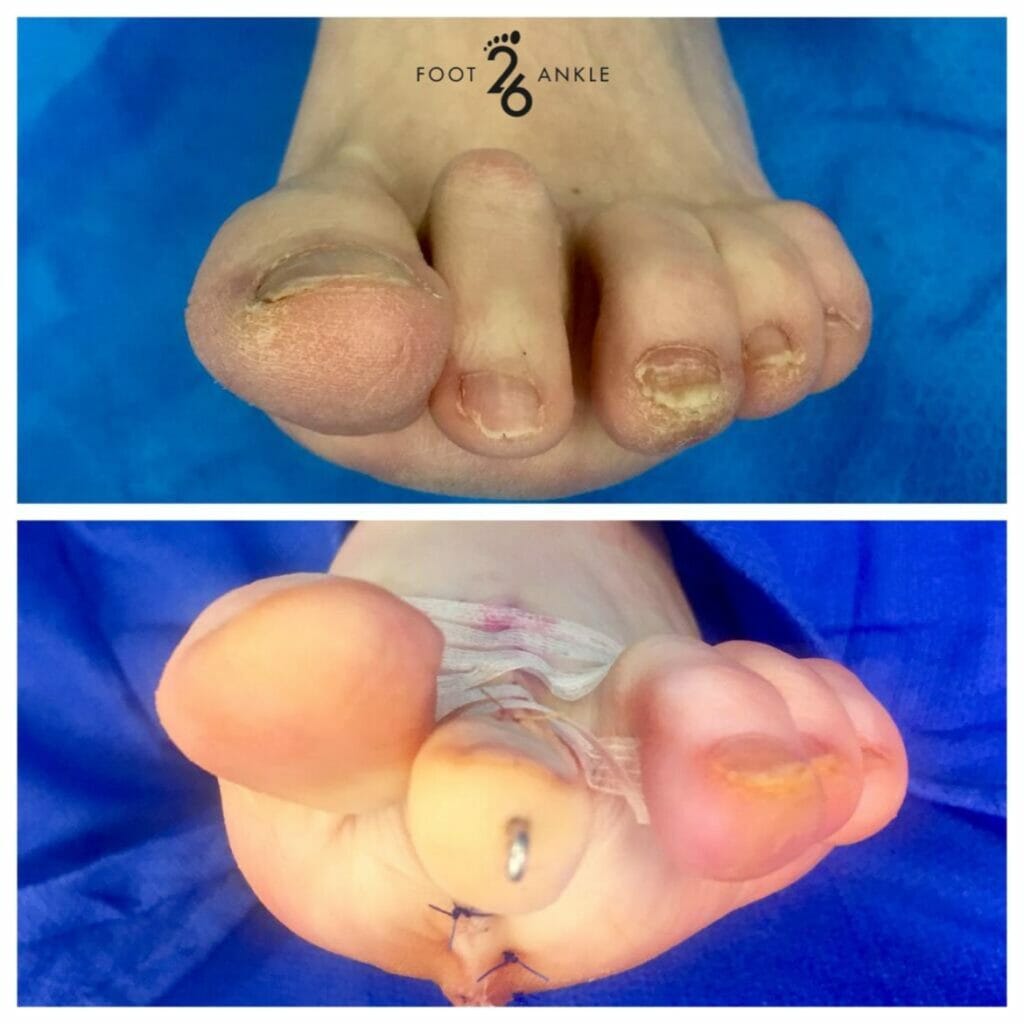The 26 Review
- What is Plantar Plate Repair? A surgical procedure that repairs a damaged plantar plate
- How The plantar plate is reattached or reconstructed using sutures.
- Why When a plantar plate tear causes pain, instability, and/or reduced function
- Recommended for Individuals with symptoms including pain, instability, and toe deformities
- Length of Treatment Surgery typically ranges from 1 to 2 hours
- Downtime 4-6 weeks in a protective walking boot
Plantar Plate Repair E-Book


Plantar Plate Repair
Elevate your foot health journey with our complete guide on Plantar Plate Repair. Uncover all the information of this procedure designed for lasting relief. Our expert guidance ensures you step confidently into a life free from discomfort. Download and read now to start your transformative journey!

Let’s take a closer look…
Plantar plate repair is a surgical procedure designed to address significant damage or tears in the plantar plate, a vital ligament-like structure located in the foot’s metatarsophalangeal joints. This procedure becomes necessary when conservative treatments fail to alleviate symptoms such as pain, instability, and toe deformities. During the surgery, the damaged plantar plate is meticulously repaired through reattachment or reconstruction using sutures or fixation methods. Following the surgery, patients typically wear a protective boot or cast for several weeks and gradually transition to weight-bearing activities under the guidance of physical therapy. The overall recovery process can span several months to a year, aimed at restoring foot function and alleviating discomfort for a better quality of life.
Procedure Details: Pre, During & Post Surgery Expectations
Prior to undergoing plantar plate repair surgery, thorough preoperative assessments are conducted. This involves a comprehensive evaluation of the patient’s medical history, physical condition, and diagnostic imaging, such as X-rays and possibly MRI scans, to precisely determine the extent of the plantar plate damage. The surgeon discusses the procedure, potential risks, benefits, and expected outcomes with the patient, addressing any questions or concerns. Preoperative instructions might include abstaining from food and drink before the surgery, stopping certain medications, and arranging for post-operative care and transportation home.
During the surgery, the patient is usually placed under anesthesia to ensure comfort throughout the procedure. The surgeon makes an incision near the affected joint, carefully accessing and assessing the damaged plantar plate. The extent of the tear guides the surgical approach, which can involve reattaching the ligament to its proper position or performing a reconstruction using sutures or fixation devices. Additionally, it is not uncommon that any associated hammertoe deformity will need to be corrected at the time of surgery as well. Ensuring proper alignment of the joint and the repaired plantar plate is vital for the surgery’s success. Once the repair is completed, the incision is closed, and the foot is protected with a cast or boot to support healing.
Post-surgery, the patient enters a critical phase of recovery that involves following the surgeon’s guidelines for wound care, pain management, and rehabilitation. The initial weeks often require partial weight bearing to allow the repaired plantar plate to heal properly. Gradual weight-bearing is then introduced, accompanied by physical therapy to restore strength, flexibility, and function. Recovery duration can vary based on the individual’s healing rate and the extent of the initial damage. Patience and adherence to the rehabilitation plan are essential, as returning to full activity levels may take several months. Monitoring for signs of infection, monitoring healing progress, and regular follow-up appointments are crucial components of the post-operative process to ensure a successful outcome.

Benefits and Risk Factors
Plantar plate repair surgery offers several benefits for individuals suffering from significant plantar plate damage. The procedure aims to alleviate chronic pain, instability, and toe deformities that impact daily activities and quality of life. By restoring the integrity of the plantar plate, the surgery can enhance joint stability, prevent further joint misalignment, and reduce the risk of associated complications. Moreover, successful surgery can lead to improved foot function and mobility, allowing individuals to return to their desired level of physical activity without discomfort or limitations. Early intervention with plantar plate repair surgery can potentially prevent the need for more invasive procedures in the future.
However, like any surgical procedure, plantar plate repair surgery comes with inherent risks. Infection at the surgical site is a possible complication, although steps are taken to minimize this risk through sterile techniques and post-operative care. There’s also a chance of nerve damage during the surgery, which can lead to numbness or altered sensation in the affected area. Additionally, surgical procedures carry a risk of blood clots, and patients are often advised to move their legs periodically to reduce this risk. Anesthesia-related complications are rare but can include allergic reactions or adverse effects. Notably, the success of the surgery depends on various factors, including the surgeon’s skill, the patient’s overall health, and the extent of the initial damage. It’s essential for patients to have a comprehensive discussion with their healthcare provider to weigh the potential benefits against the risks and make an informed decision about the best course of action.

